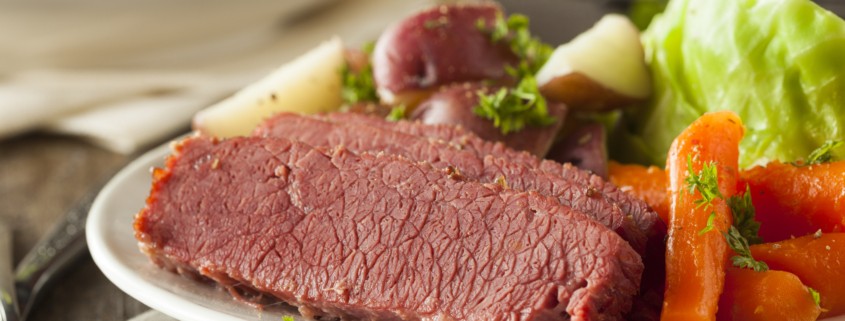A St. Patrick’s Day Feast!
It may not be an authentic Irish meal, but corned beef with cabbage is an American tradition for a St. Patrick’s Day Feast. It also pairs well with our 2021 Texas Lenoir, so pick up a couple of bottles next time you come to visit! You’ll want some while you prepare this delicious meal and of course, more to serve with dinner.
Corned beef with cabbage and carrots
Guinness Gravy
Roasted Potatoes (anchor link to Lumber jack night potatoes recipe)
Irish Soda Bread
Brining Beef
You don’t have to use brisket for corned beef. It just makes the most sense if you are feeding a crowd. But for a smaller group, there’s no reason you couldn’t use a beef tenderloin or New York Strip. You can also buy your beef already brined, but it’s pretty simple to do it yourself and the result will be dramatically better.
My favorite brine is made with pickling spices from Natural Grocers, but you may have the ingredients in your pantry. If not, the local Mexican market usually sells these spices whole in small packages, or check the La Fiesta spice section at your nearest HEB.
Brine for steaks or whole beef tenderloin
Spice mix:
- 1 tbsp. coriander seed
- 1 tbsp. dill seed
- 1 tbsp. mustard seed
- ½ tsp. allspice berries or one cinnamon stick and a few whole cloves
- 2 tsp. peppercorns
- 2 bay leaves
- Optional: chili flakes, dehydrated garlic or onions, juniper berries
- ¼ c. salt
- ¼ c. raw cane sugar
- ¼ c. apple cider vinegar
- 1 qt. water
Warm up the water on the stove, or use hot water from your tea kettle to melt the salt and sugar into the vinegar and water. Place the meat in a deep dish or resealable bag, add the spices and brining liquid, and seal. Allow to marinate 5-7 days for whole briskets, 3-5 days for beef tenderloin, and 1-3 days for steaks. Drain well before cooking.
A tenderloin will fare best when roasted whole until it hits 130 degrees, and then allowed to rest for 15 to 20 minutes, tented with foil before serving, or sliced into three inch pieces and quickly seared in a little butter and olive oil. You won’t need salt, but you can add a little black pepper and garlic powder to the meat while cooking.
Sides
Depending on how you plan to cook your meat, you can throw your veggies in, or keep them on the side. Traditionally, the cabbage is boiled with the beef. But you can stir fry it to retain more nutritional value. Add shredded carrots and red onions or sweet peppers to give the dish more color and depth of flavor. Save yourself prep time by purchasing coleslaw mix.
Potatoes can be cooked alone until tender, then mashed and mixed with cream, butter or olive oil, salt, and pepper, or try the smashed potatoes from LUMBERJACK NIGHT.
Guinness Gravy
You need about 4 ounces of roux for a quart of medium bodied gravy. That’s half a cup. The ratio of fat to flour in a roux is 1:1. So a ¼ cup of flour needs a half a stick of butter, or 2 ounces of fat, for each quart of liquid. That’s 4 TBSP of bacon fat or coconut oil. If you have pan drippings, add at least ¼ stick of butter to the pan and melt before adding your flour.
Over med-high heat, mix the flour with the fat until completely incorporated, and continue to cook for 5-8 minutes, until the color deepens to a golden brown. Add a can of Guinness or dark beer, one cup at a time, stirring constantly to remove any lumps before adding more liquid. Once all the liquid has been added, lower the heat and simmer for ten minutes, stirring frequently. Check the seasoning and adjust.
How to adjust seasoning:
If it’s really salty, use heavy cream or more beer to expand the sauce.
If it’s thick but not salty enough, use beef broth.
If it tastes great but it’s too thin, use a slurry of corn starch and cold beer or water to thicken.
Check the seasoning again. If it tastes too flat, add some Worcestershire or soy sauce and a few dashes of black pepper and dry mustard, and taste again before adding any salt.
Irish Soda Bread
- 4 c. flour
- 1 tsp. salt
- 4 tsp. baking powder
- 1 ¾ c. buttermilk
If you have never tried your hand at making bread, this is the easiest one to master. Lightly mixed by hand, it requires no yeast or rising time. It’s a hearty bread that goes well with savory food or as a platform for butter, jam, and cream cheese for breakfast.
Once you learn how quick and easy it is to pull this off, you’ll want to start adding things like fresh herbs, dried fruit, nuts, and seeds. Try dried pineapple and coconut flakes, cranberries and pecans, or rosemary and parmesan.
Prepare your pan or cast iron skillet with pan coating, or parchment paper. Preheat the oven to 400 degrees.
With a whisk, combine dry ingredients in a large mixing bowl. Using gloved hands with a small amount of oil on them, pour in half the buttermilk and hand mix, using a loose, claw-like hand gesture to scoop flour from the bottom and then flip over toward you, until the flour and liquid just comes together. Resist the urge to knead it. It should look like a shaggy biscuit dough.
Turn the dough onto the greased pan and shape. Clean your hands and grab a big knife. Score multiple times, at an angle, 3-4 inches apart.
Bake for 25-30 minutes and turn. Check again at 45 minutes. Large loaves will take up to 55 minutes. Tent with foil if the bread starts to brown before the inside is done. Allow to cool for 10-15 minutes before serving. For maximum shelf life and freshness, keep refrigerated and consume within 3-5 days or freeze extra the day you bake it, up to 3 months. Toasting it whole or sliced in the oven will give it new life after cold storage.
Happy St. Patrick’s Day, and enjoy!
Love,
Kristie Stevens




